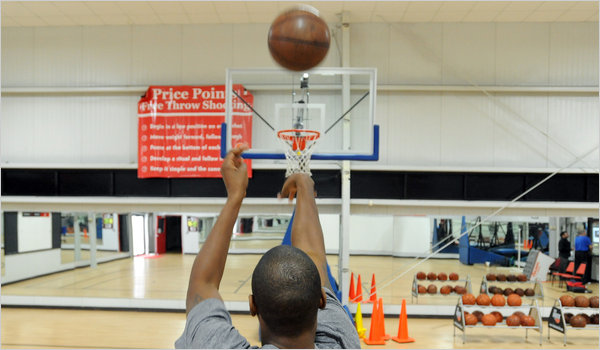Mark Price Shooting Lab Helps Make Swishes Come True

By Mike Tierney - New York Times
Andres Sandoval toes the free-throw line, gazes at the rim and lets fly.
As the free throw swishes, the building’s silence is broken by a disembodied voice announcing “46.” Another nothing-but-net, another “46.” Sandoval follows with one more 46, a 43 and a 49, all of which reflect the angle of the ball’s arc.
At courtside, the device speaking in a computerized monotone has snapped high-speed digital photographs of Sandoval’s shots and combined them. The composite is displayed on a screen, with color arcs tracking the trajectory of each try. The ideal for a standard player is 45, though Sandoval earns a solid green.
The screen also indicates precisely where the ball, which is a little less than nine and a half inches in diameter, lands inside the rim, which is 18 inches in diameter. The objective is for the center of the ball to hit 8 to 10 inches inside the rim. Sandoval usually settles on 12.
Bruce Kreutzer is the man at the equipment’s controls for Sandoval, a former college point guard and Dominican Republic national team player who is aiming for a spot in the N.B.A. Development League. He has fallen into a parade of professionals who have wound their way to the Suwanee Sports Academy, 35 miles northeast of Atlanta.
The academy caters primarily to youngsters in several indoor sports, mostly basketball. A small section tucked off to the side is a minigymnasium less than a halfcourt in length. It has a low ceiling, mirrored walls and a scruffy floor. A sign identifies it as the Mark Price Shooting Lab, whose namesake and director needed no machines or technology to become an N.B.A. dead-eye.
“I call it the A.A. of shooting,” said Price, 46, a retired four-time All-Star who is the most accurate free-throw shooter in N.B.A. history (.904) and is 23rd in career 3-point percentage (.402). Through computer-generated video and stills, he said, “You show them, and they go, ‘I’ve got a problem.’ ”
The lab’s most renowned problem case was Boston Celtics point guard Rajon Rondo, whose transcendent 2009-10 season was in small part a result of Price’s handiwork. Rondo arrived with a host of maladies — a flying elbow, which he neglected to keep tucked in; imbalance because of poor foot placement; and a habit of bringing the ball too far back before launching.
Two dozen N.B.A. players, former gym rats all, have become Price’s lab rats in the off-season, along with others from the Development League, for which Kreutzer, the lab shooting coach and operator, is a consultant.
Not all participants’ identities are disclosed; some consider the sessions a form of rehabilitation that deserve privacy.
Thaddeus Young, one of several Philadelphia 76ers to take part, said by telephone that he came out of the lab an improved, though not finished, product (his 2-point shooting is up this season, his 3-point shooting is down). Young’s shot was partly retooled, with emphasis on positioning his feet. He offers an unsolicited endorsement.
The standard program covers five days, with two-hour sessions in the mornings and afternoons. The fee is $2,500.
Sandoval visited the lab, whose clientele includes youngsters and middle-age recreation-league players, out of curiosity. “I thought my shot was O.K.,” he said, until noticing a girl in her early teens nailing one jumper after another. He signed up.
Kreutzer, typically, zeroed in on Sandoval’s footwork. “I had been taught to hop into a shot,” Sandoval said. “With Bruce, everything is on my toes.”
On free throws, the old Sandoval would lower the ball below his waist before unleashing. Now, on a good day, it drops no farther than his chest. Before Sandoval could disclose further details, Kreutzer cut him off with a smile, wishing not to have too much proprietary information revealed.
Sandoval is receiving three-on-one attention. Besides Kreutzer, there is the courtside contraption, cleverly called Noah after the biblical character who built the perfect ark and not Joakim Noah, whose awkward shot could use it.
The machine, which has been on the market for five years, is the brainchild of Alan Marty, a software specialist. He began teaching his daughter about the benefits of a high arc in a low-tech manner, with a rake rigged to a ladder, and came up with the sophisticated gadget. Its no-frills version sells for $3,999.
Noah, used by some N.B.A. teams, is designed to help build muscle memory, helping shooters stay in range of their natural arc.
“It’s like an arcade game; it becomes contagious,” Kreutzer said.
The lab also uses the video technology Dartfish, with cameras filming a shooter from the side and the rear. Kreutzer and the instructor analyze the content on a 42-inch flat-screen television.
“I can’t think of a single guy who hasn’t improved working with us,” Kreutzer said.
Betterment cannot always be measured statistically. The season after Rondo’s graduation, his 3-point shooting declined 10 percentage points and his free-throw percentage by 2 points. His 2-point number rose by almost 2 percentage points.
This year, Rajon’s field-goal figures are improved. But his free-throw shooting has plunged to 43 percent, suggesting he may need a checkup.
Kreutzer would welcome one of the N.B.A.’s most frustrated free-throw shooters, Dwight Howard of the Orlando Magic (.596 for his career), but Howard, a native Atlantan, has yet to respond to feelers.
Acknowledging that Howard practices as much as anyone, Kreutzer said, “If you practice something that’s incorrect, that maximizes the negatives.”
Old-school banners on the wall provide axioms from Price, who has turned most duties during the season over to Kreutzer since becoming a Golden State assistant. “Quick but don’t hurry,” reminds one. Another says: “Practice game shots at game speed.”
If, as another axiom holds, shooting is a lost art, the lab considers itself an art-restoration project.